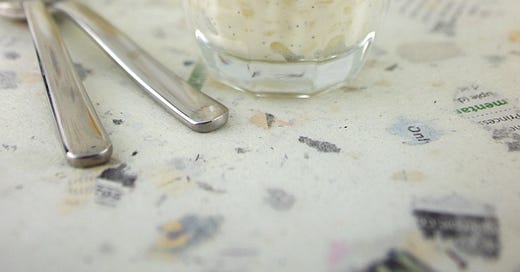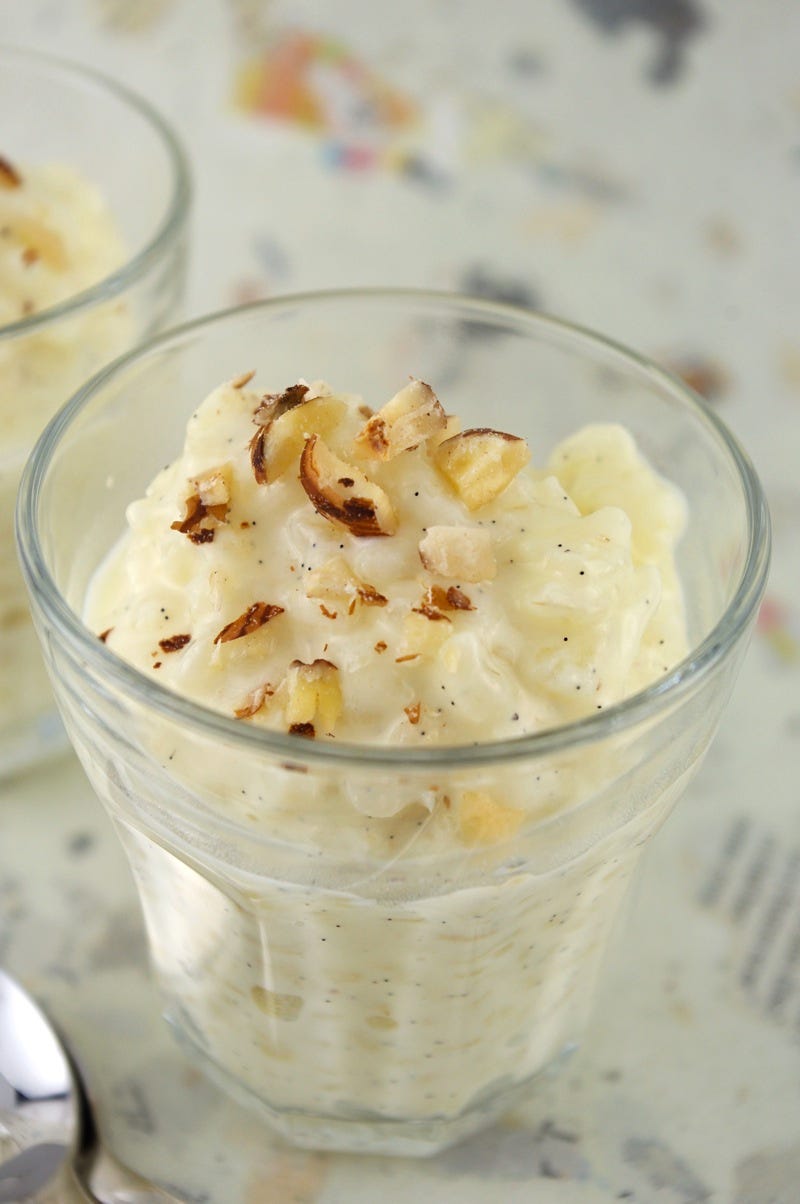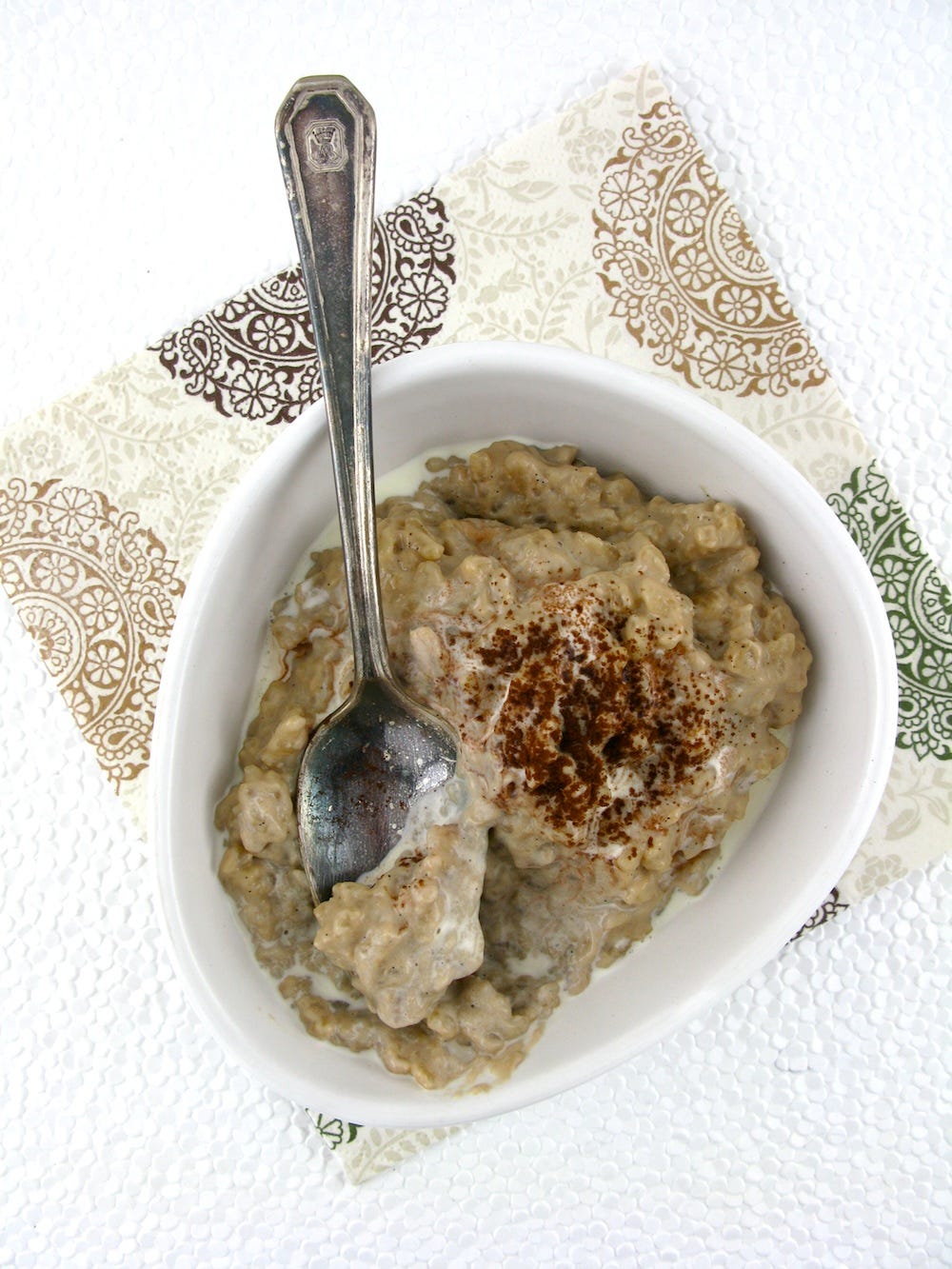The greatest dishes are very simple. - Auguste Escoffier
I did not grow up with rice pudding; this was something not in my culture at all. Pudding - boxed, for that matter - yes. Jello, of course. But never rice pudding. I don’t even think that I knew rice pudding existed until my French husband requested it one day. Oh, no, correction: not rice pudding. Riz au lait, the French version of this nursery snack. I brushed it off as something too simple, as not interesting. Panna cotta, budino, crêmet, crème brûlée, mousse, now those were interesting things to prepare, more surprising to serve.
My husband grew up in a very traditional working class French home. Desserts were rare, snacks were limited and both were always simple, plain and unadorned, and always homemade. And he grew up on riz au lait, the Frenchman’s version of rice pudding, creamy, sweet, warm and filling. Just as each baby, he and his siblings, was bottle fed with bouillie, cereal-thickened milk, each toddler, as they became toddlers, and then children, were served up big, steaming bowls of riz au lait. An old-fashioned woman, ma belle-mère, my mother-in-law Madeleine believed in plumping up her children with fat-and sugar-rich treats, sometimes in the place of a savory meal, and that meant puddings made with either rice, vermicelli, semolina, or tiny elbow macaroni long-simmered in whole milk until soft and pudding-like and sprinkled with sugar. A lot of sugar. These dishes were meant to fill up the growing children, to insulate them against the cold and damp of winter, or to simply add on the pounds, an old-fashioned way to help them grow faster. I’ve watched friends of my own generation prepare the same food for their own children, adding dried fruits and nuts for more nutritional value, but always the same dish. Riz au lait.
The way my husband described it, receiving bowls of riz au lait as something almost healthful, a curative in a kind of medieval way like gruel or cod-liver oil, it surprised me that he thought of it with fond nostalgia rather than as a sort of punishment, the “it’s good for you” reproach from some stern adult standing tall and large one step back, brows furrowed. Big bowls clunked down on the table, the grind of chair legs across wooden floors as the seat is pushed up to the edge, the spoon within easy reach of small pegs of arms. A weighty snack meant to fill up on the cheap, day after day, adding a layer of winter fat, bulking up small bodies, protecting against whatever ails them.
Rice cooked in sweetened milk is a recipe that is probably as old as the cultivation of rice itself, a dish traced back to Central Asia, Iran and Iraq, and India, in the form of flavored puddings, and probably the oldest known dessert - quite possibly the Indian kheer was the original rice pudding . During the Roman through the Byzantine Empires, the dish was considered health food if not downright medicine, often being eaten to resolve digestive problems. Later we’ll find throughout Europe, over the course of the centuries and right into our own, this dish was still fed to invalids or to young women considered “too thin” as a food meant to fatten and fortify. Jean Bruyérin-Champier, King François I’s doctor, penned De Re Cibaria - Des Aliments or, simply, Food - in 1560 and included a recipe for riz au lait writing “We imagine that rice makes you grow [...] In the (royal) court and in the large cities, some ladies who are too thin eat rice very often [...] taking it with milk and lots of sugar.” Astonishingly, until the end of the 18th century, riz au lait appears primarily in pharmaceutical and dietary recommendations for both humans and animals (the latter most likely sans sugar).
Considering rice wasn’t introduced into Europe - in France specifically - until the 14th century, and not widely cultivated until closer to the 17th, this dish was still unknown by the masses. (It is thought that Louis IX was served a dish made with rice and almond milk perfumed with cinnamon on his way to the crusades in 1248 - certainly more as reinforcement than a dessert - but this dish seems closer to the French blanc-manger than a riz au lait… and blanc-manger must wait for another Substack.) At the end of the Middle Ages, le ris engoulé, as it was called, was made by cooking rice in milk with saffron and beef broth to be eaten on “fat days” preceding Ash Wednesday; during Lent it was prepared with almond milk, sugar, and cinnamon. But as noted above, rice wasn’t yet a common grain so these were dishes found on noble or aristocratic tables as a luxury. Porridges or gruels made with grains were commonly prepared in lower class homes during this period, but as rice was not yet widespread throughout the country these dishes were made with millet, barley, or other common grains and savory rather than sweet, made with meat broth rather than milk.
Riz au lait begins appearing in cookbooks in France in the 14th and 15th centuries, most notably in Le Ménagier de Paris, The Parisian Household Book, by a young upper class Parisian bourgeois gentleman, a work of domestic economy written in 1393 for his future wife on a woman’s “proper behavior in marriage and running a household.” A recipe for rice pudding as a dessert appeared in a medieval Dutch cookbook in the early 16th century and a “riz au lait bien sucre” - a well-sweetened rice pudding = was mentioned in La Varenne’s Le pâtissier françois - the French Pastry Chef - published in 1653. Le Nouveau Cuisinier Royal et Bourgeois ou Cuisinier Moderne by M. Massialot published in 1750 has the recipe for a lovely yet simple Riz à la chancelière, rice cooked in milk then blended with handfuls of sugar in a silver dish, dusted with fine sugar and cinnamon and baked, a mode of cooking rice puddings or gâteau de riz, molded in cake form, that was becoming more popular than cooking it on the fire. It’s difficult to find many recipes of any version of this dish in the more famous cookbooks until Antonin Carême’s Le Pâtissier Royal Parisien of 1815 where the world’s most illustrious chef goes wild with rice desserts, but each worthy of a noble, made elegant and sophisticated with liqueurs and fruits.
2 more recent recipes stand out that really set the stage for bringing this humble, comforting dish into the modern French home in this standard but wonderful form:
Austin de Croze, French writer, folklorist, musician, journalist, gastronomic author and oenologist, and founder of the Regionalist Cuisine movement, gives a recipe for riz à la Bréhatine, a specialty of Brittany, in his tome Les plats régionaux de France. 1400 succulentes recettes traditionnelles de toutes les Provinces françaises - Regional Dishes from France. 1400 delicious traditional recipes from all the French provinces - published in 1928: “In a large terracotta basin, put 8 liters of unboiled milk, 500 grams of good rice, 500 grams of sugar, one spoon of salt. Carry this to the baker so the dish can be put in the oven as soon as the bread is taken out and leave (the pudding) in the oven five or six hours, until the oven is cool. This is a comfortable/cozy dessert for about 30 people truly appreciated on wedding days or “jours de mécanique” - this last has us a bit confounded, possibly a day on the farm when large groups of people would arrive to help with harvest. He follows this with a similar recipe for “Parisian tables” - Parisians evidently didn’t carry basins of rice pudding to a local baker to place in his bread oven - using smaller quantities of each ingredient with the addition of a vanilla bean and cooked in a “copper, aluminum, or porcelain pot”.
Auguste Escoffier has a much more complicated and richer version of this homey sweet in his 1934 cookbook Ma Cuisine, first cooking the rice with sugar, salt, and butter in milk infused with vanilla and orange and lemon zests until the boil, then baking in the oven. Once cooked, he stirs in egg yolks, folds in egg whites beaten until stiff, pours this into a mold then cooks in a bain-marie.
My own recipe is so much simpler than Escoffier’s, very simple and very homey riz au lait, true comfort food in a French home. This version, because of its simplicity is also really versatile in that it can easily be flavored as you like, by stirring in chopped nuts or raisins plumped in warmed amber rum, infused with orange or lemon juice and zest, spiked with rum or Amaretto, or flavored with grated dark chocolate, cinnamon, cardamom, nutmeg, or instant espresso powder; or serve it with crème anglaise or stewed fruit or berry coulis, or drizzled with warm chocolate or caramel sauce. But we find that it is just perfect as it is, mere child’s play.
In my next Substack, we will explore the fancier versions of this dessert.
Riz au lait
7 ounces (200 grams) uncooked round rice for risotto or pudding
3 ¼ cups (750 ml) whole milk or half low-fat milk + half light or heavy cream
7 - 8 tablespoons (100 – 120 grams) sugar, divided, or to taste
Pinch of salt
1 vanilla bean
1 tablespoon (15 grams) unsalted butter
Heavy or light cream, optional
Place the rice in a sieve or colander with tiny holes (so as not to lose any rice out the bottom!) and rinse under running water until the water runs clear. Drain.
Place the rinsed rice in a saucepan and cover with water; bring the water to a boil and allow to boil for 5 minutes. Drain the rice.
Return the drained rice to a medium-sized saucepan with the whole milk (or half low-fat milk and half cream), 1 tablespoon of the sugar, and a pinch of salt. Using a small, sharp knife, split the vanilla bean down the center and scrape out all of the seeds. Add both the seeds and the pod to the other ingredients in the saucepan. Bring the milk just up to the boil and then immediately turn the heat down to very low and, placing a cover atop the saucepan but leaving it ajar, allow the pudding to simmer, stirring often, for 30 to 35 minutes or until the rice has absorbed almost all of the liquid. The rice should be very soft, almost melting in the mouth. It should not be al dente. The pudding should be creamy, neither runny nor dry.
Remove the saucepan from the heat and remove and discard the vanilla bean pod. Stir in the tablespoon of butter and about half of the remaining sugar. Taste and add as much of the remaining sugar until desired sweetness. If you like a rice pudding that is less thick or creamier, or if you want a richer pudding, stir in just enough light or heavy cream until the desired consistency and gently heat through.
Spoon into individual serving dishes, glasses or bowls. Eat warm or room temperature.
For a rum raisin version, soak 2 tablespoon raisins in 3 tablespoons dark or amber rum while preparing the riz au lait. Add the raisins and the rum about 10 minutes before the end of the cooking. Add more milk if the rice becomes too thick and gluey rather than smooth and creamy and heat through.
For a café latte version, add 5 grams instant espresso powder (about 1 tablespoon + 1 teaspoon, more to taste) with the 1 tablespoon sugar, the pinch of salt, and the vanilla bean to the drained rice and the milk before cooking.
Thank you for subscribing to my Substack, Jamie Schler’s Newsletter, where I share my (mostly French) recipes, my hotel and my jams, my projects, and the stories of my life. You can support my work by sharing the link to my Substack with your friends, family, and your social media followers. I’m so glad that you’re here.








Growing up in the Midwest I thought the "only" way to eat rice was Rice Pudding until I went to college! ;)
This brings me back 50 years to when my Dad would ask for rice pudding for dessert. It was always his favorite. Thanks for the sweet memories.❤️